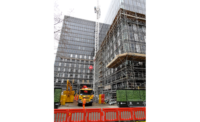Having progressively whittled down the scope of its ambitious high-speed railroad plans, the U.K. government on Oct. 4 finally killed off prospects of a national HS2 network by canceling a key 51-mile section between Birmingham and Manchester.
Only half of the 340-mile HS2 network launched 13 years ago is still planned for completion, with high-speed travel possible only between London and Birmingham for the foreseeable future.
Addressing his Conservative party conference in Manchester, Prime Minister Rishi Sunak said, "I am ending this long-running saga...I am cancelling the rest of the HS2 project."
With costs doubling and schedule delays, he called the program an "example of the old consensus" and pledged to spend $46 billion on countless smaller projects across the country.
Sunak also ended program company HS2 Ltd. control of the troubled London terminal project at Euston. "There must be some accountability for the mistakes made and the mismanagement of this project," he added.
Attacking Sunak's decision, Marie-Claude Hemming, operations director of the Civil Engineering Contractors Association called it "a dark day for the U.K. economy and for everyone who has placed trust in successive U.K. governments to level up the country and close the north-south divide."
Canceling the project "undermines investment in the U.K.," says Mark Reynolds, CEO of MACE Group, which has several contracts on the program.
 The HS2 plan originally called for 340 miles of high-speed rail linking the north and south of England. Map Courtesy of HS2 Ltd.
The HS2 plan originally called for 340 miles of high-speed rail linking the north and south of England. Map Courtesy of HS2 Ltd.Chair of the government's National Infrastructure Commission, John Armitt, shared that view. Anticipating the announcement, he asked "what are we saying to the rest of the world?...Here is a country that sets itself ambitions and then runs away when its starts to see some challenges."
Estimated to cost as much as $23 billion, the 51-mile canceled section was to have connected Manchester with Crewe. The project was still going through the parliamentary authorization process. High-speed trains north of Birmingham will now run on the conventional, busy tracks of the West Coast Main line.
The roughly 37-mile section from Crewe to Birmingham was already paused this March, by two years, along with work at the Euston terminal. The planned section heading northeast to Sheffield and Leeds was canceled in late 2021.
What remains is 140 miles of tracks under construction between London and Birmingham. Budgeted at around $50 billion at 2019 prices, work is spread across 350 sites and is due for completion between 2029 and 2033.
It all looked very different in 2010 when the government launched HS2 as a Y-shaped network running north from London through Birmingham to Manchester in the west and Leeds in the east, all for a then-estimated $36 billion.
With prescience, the then-director general of the Institution of Civil Engineers, Tom Foulkes, called for the "very strongest commitment, both politically and financially."
After intensive development work and various reviews, the government formally started work on the London-Birmingham section three years ago.
 Only half of the original planned network will now be completed. Map courtesy of HS2 Ltd.
Only half of the original planned network will now be completed. Map courtesy of HS2 Ltd.In November 2021, the Department for Transport (DfT) published its Integrated Railway Plan, which among other things, canceled HS2's eastern leg to Leeds but retained the Crewe Manchester section.
HS2's high cost, greater than those experienced in France and Spain, has been a constant source of criticism. MACE's Reynolds attributed some of that to "gold plating" designs.
Before the Euston terminal project was paused, its forecast cost had risen from $3.2 billion to $5.8 billion at 2019 prices, after development work valued at $665 million, according to the National Audit Office.
After more than eight years of work, the DfT "still does not know what it is trying to achieve with the ... station," commented the U.K. Pafiliament Public Accounts Committee in July.
But the need to minimize disruption along the densely populated route in the face of strong objections also had a large influence on costs. The London-Birmingham section alone includes 63 miles of tunnels and 45 miles of cuttings.




Post a comment to this article
Report Abusive Comment